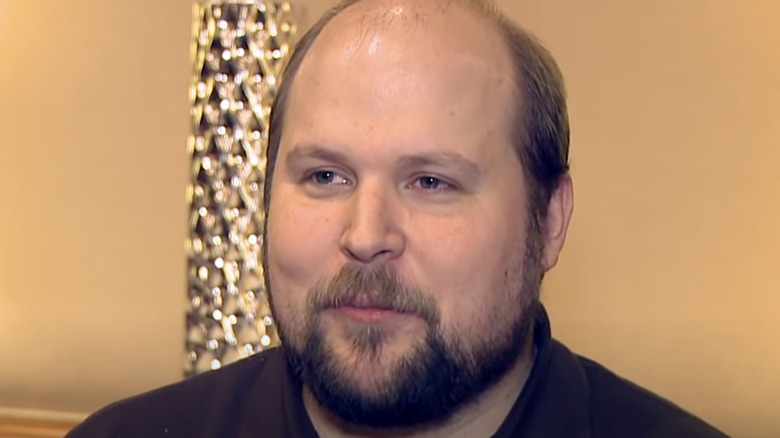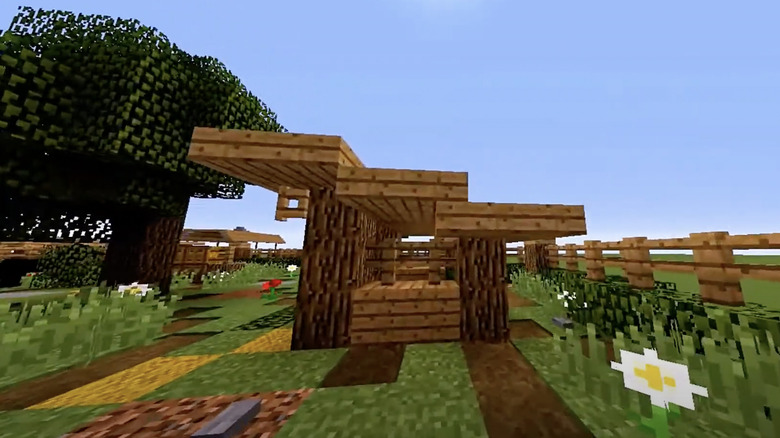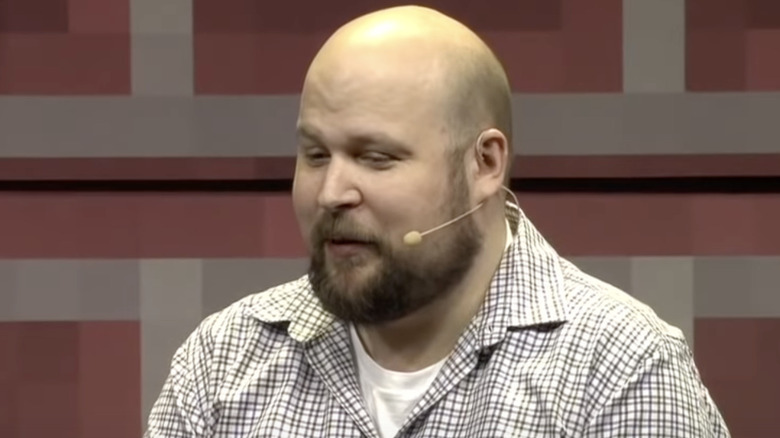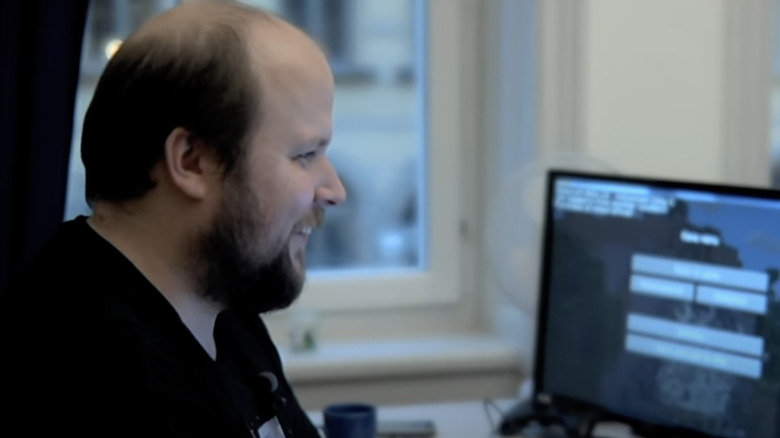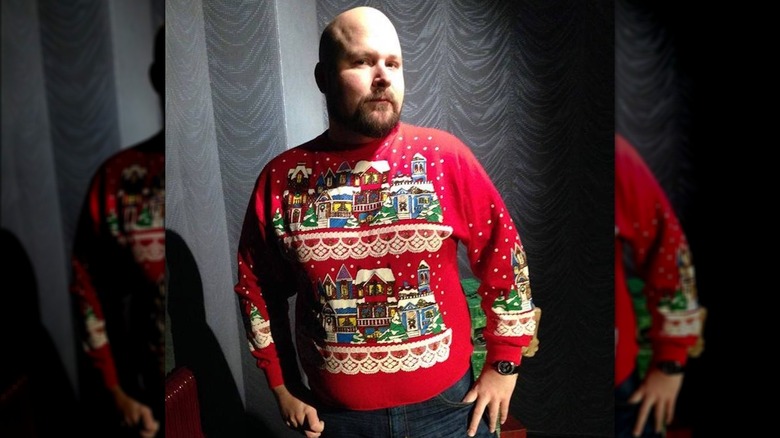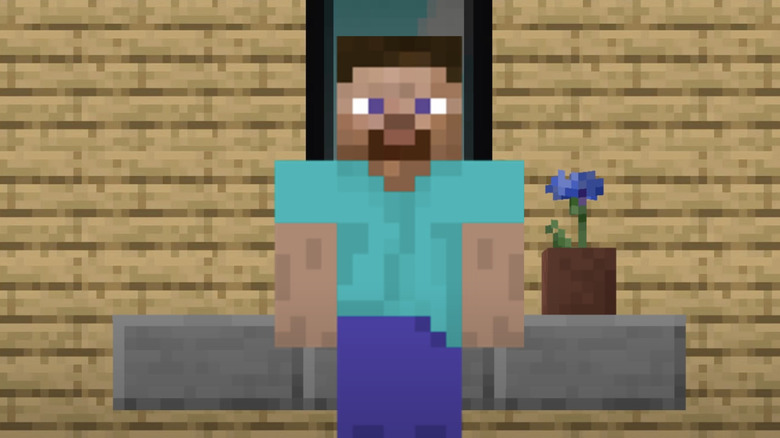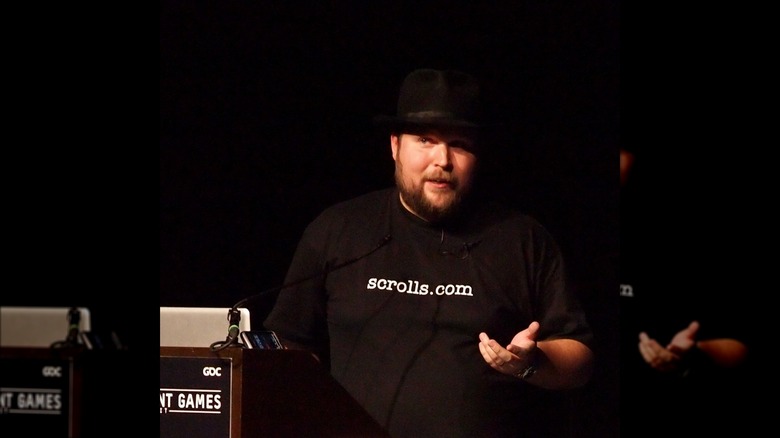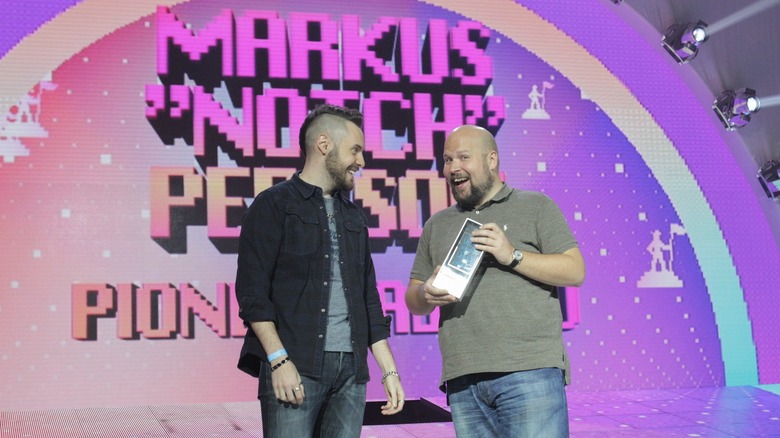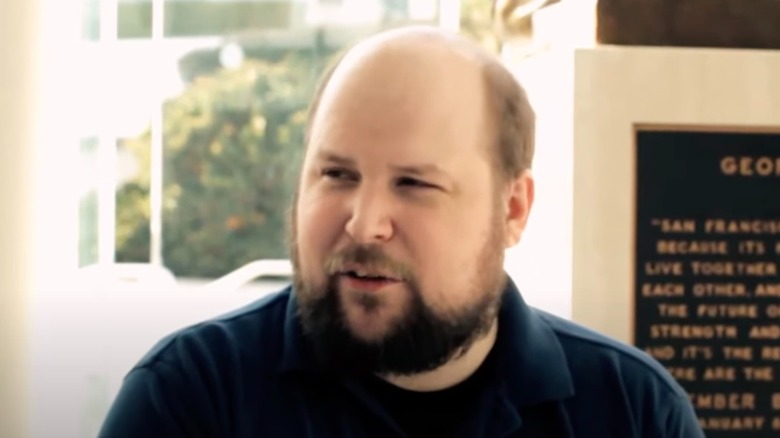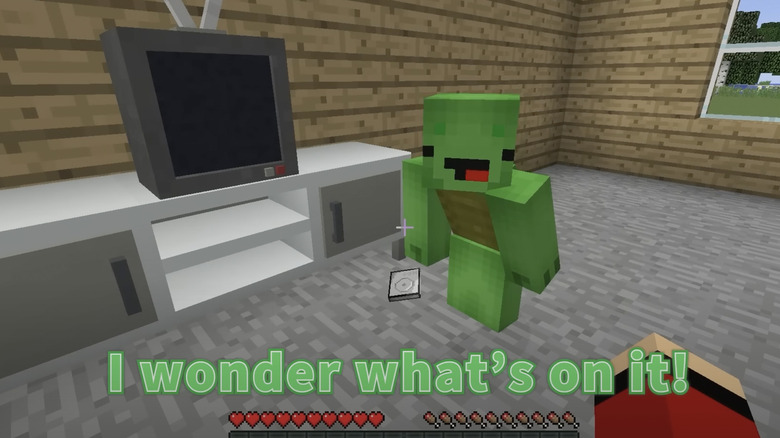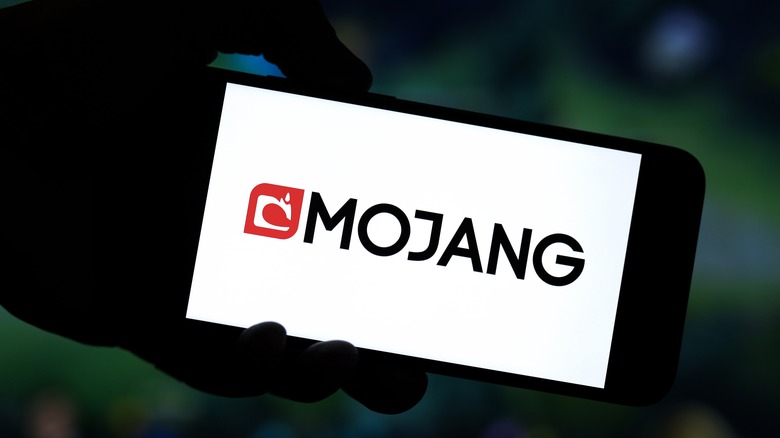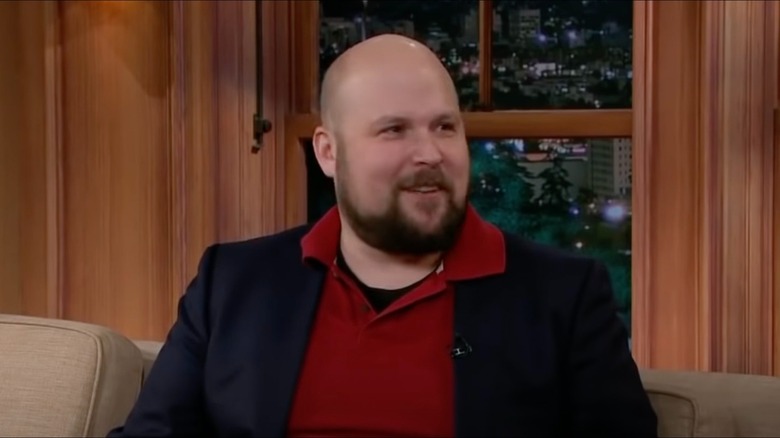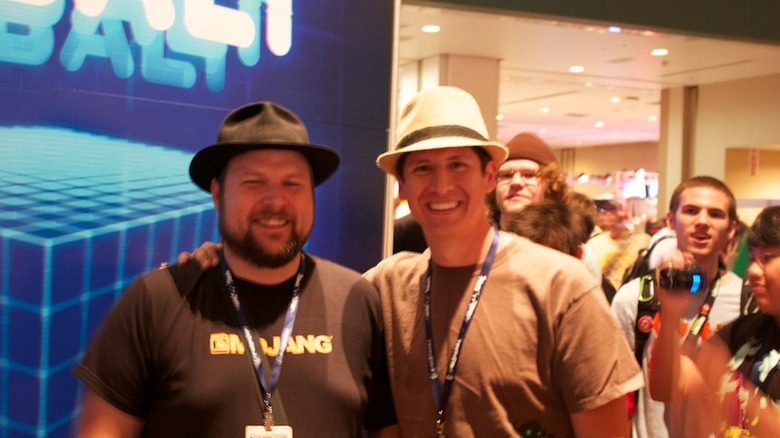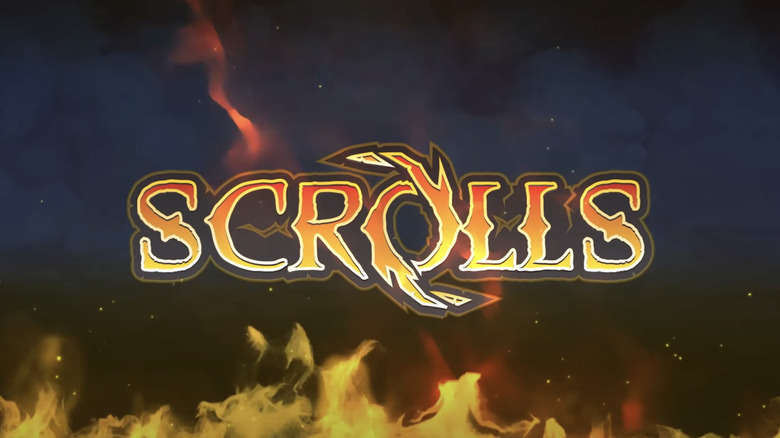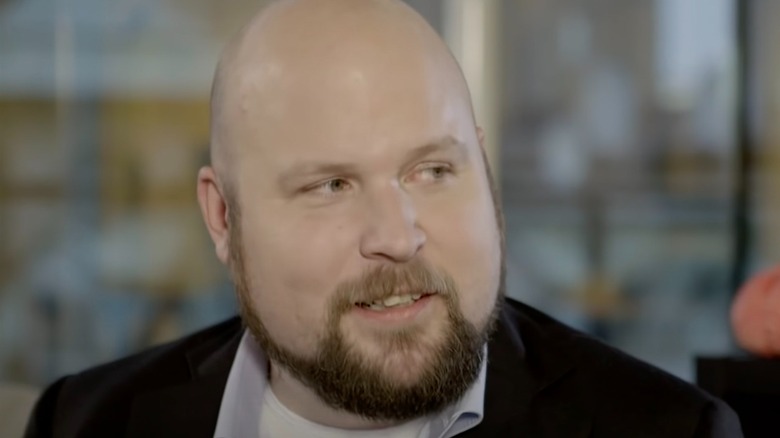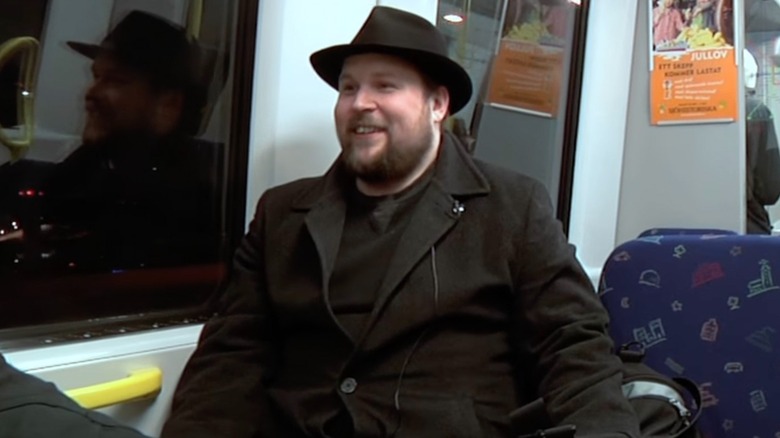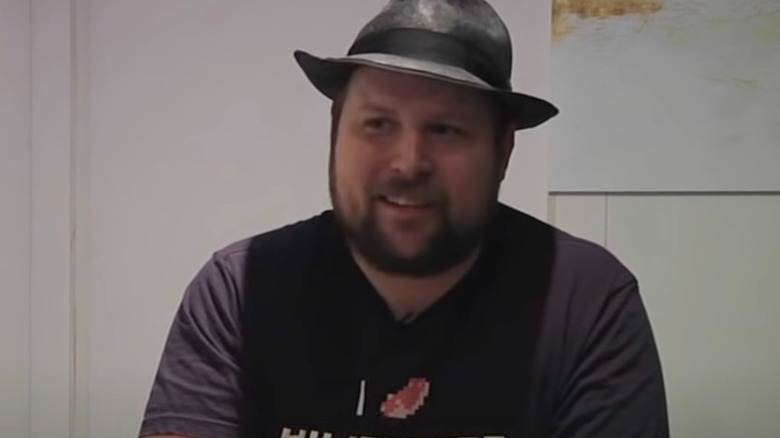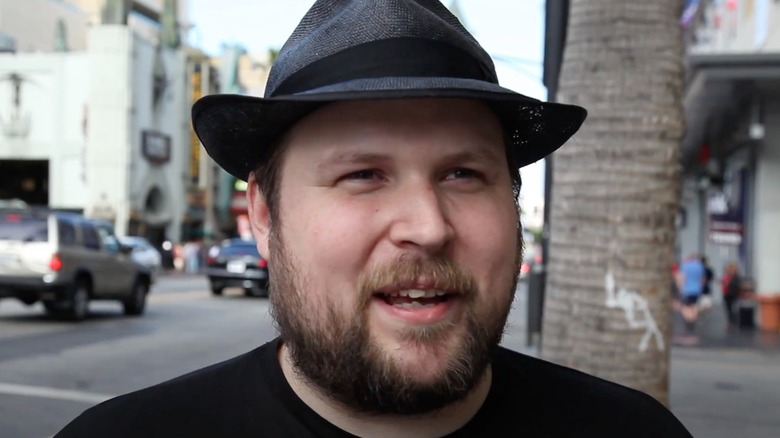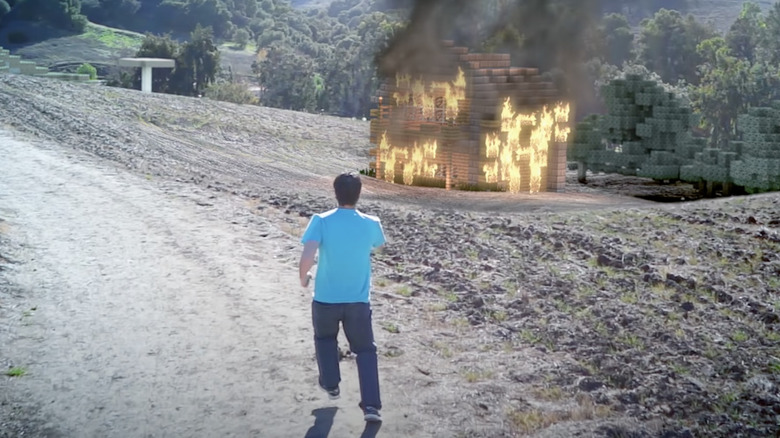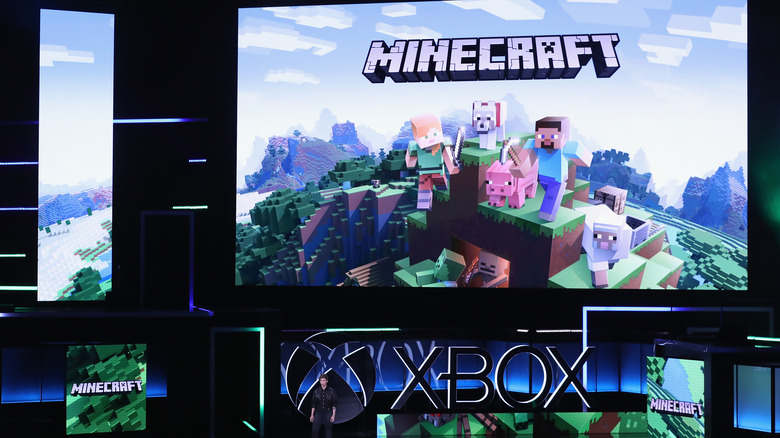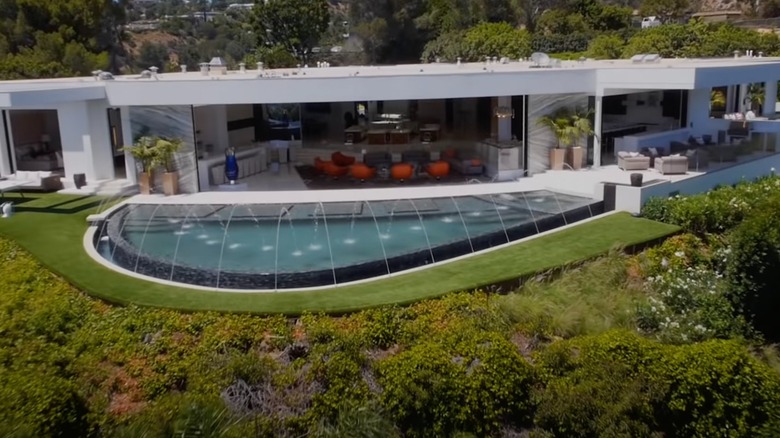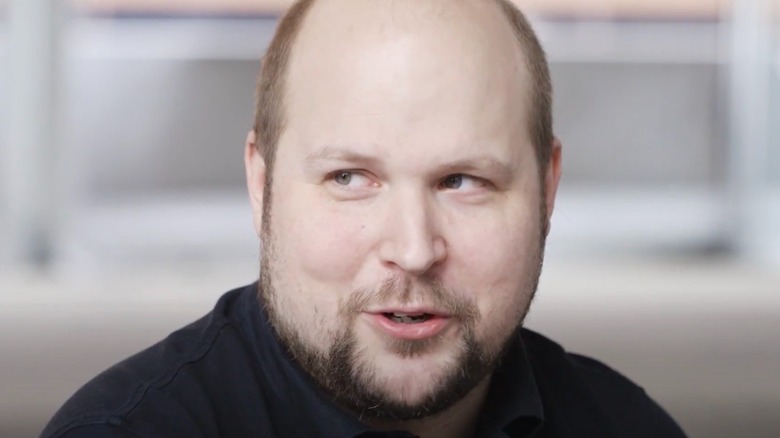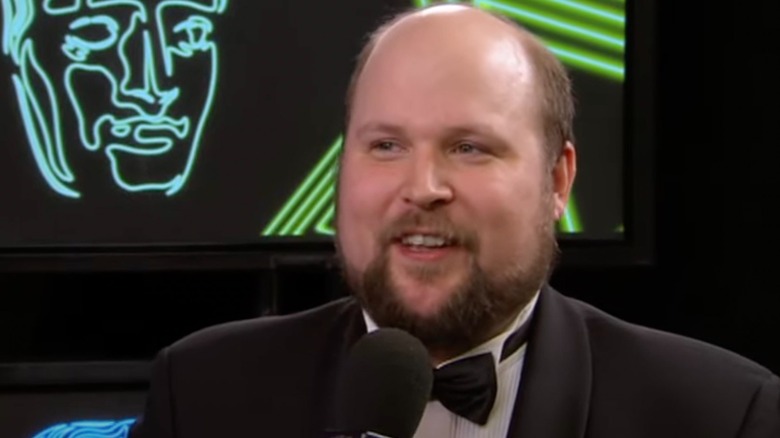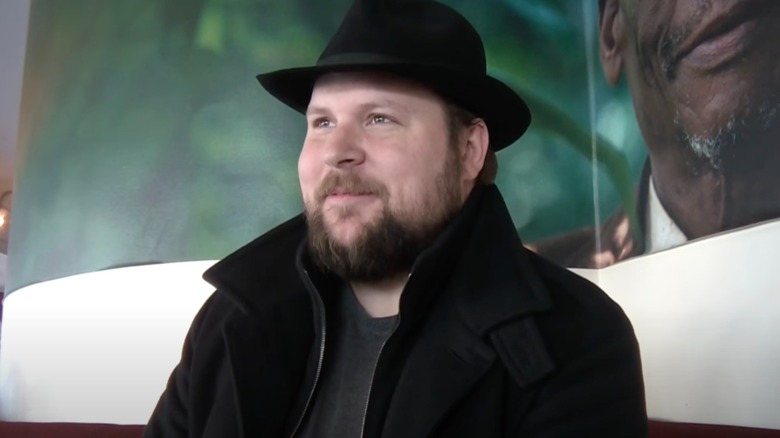The Tangled Life Of Minecraft's Creator
Initially released as a demo in 2009, "Minecraft" has gone on to become one of the best-selling video games of all time, with more than 238 million units sold amongst all platforms. Unlike other video games with sophisticated plots and hyper-realistic graphics, "Minecraft" is a simple game literally made up of building blocks rendered in a chunky, low-resolution, decidedly retro style. Like a virtual box of Lego (with quirky villains thrown in the mix), "Minecraft" has proven to be an irresistible gaming experience and pop cultural phenomenon.
Because of its unique and unlikely success as well as its origins — it's the fully-realized product of just one individual's mind — a cult of personality has developed among many "Minecraft" players surrounding creator Markus Persson. A Swedish gamer who made software for a series of small software companies, he's a billionaire because of "Minecraft," who has also publicly struggled with success, his past, his demons, and controversy. Here's a look into the complicated history and present of "Minecraft" mastermind Markus "Notch" Person.
Minecraft looks like Markus Persson's childhood
For the first seven years of his life, Markus Persson lived in Edsbyn, a rural, sparsely populated community in the interior of Sweden situated about 180 miles north of Stockholm. His mother worked as a nurse, and his father for a railroad company. Young Persson spent much of his leisure time just walking around the abundant natural areas and absorbing the sights, much of which would later inform the untouched biomes that make up "Minecraft." "We lived in this area that was basically two circular roads next to each other," Persson told Rolling Stone. "There were forests and pastures and stuff. I remember walking around the forest quite a bit."
The playing grounds of "Minecraft" resemble the areas surrounding Edsbyn, Sweden, in the 1980s. Persson believes that the game embodies "a very Swedish perception of what these things are supposed to look like."
His childhood was brutal
Markus Persson's idyllic-seeming childhood began to unravel when he was 12 years old. At age seven, Persson, his parents, and his sister moved into the metropolis of Stockholm. Five years later, Persson's mother and father divorced, and his father moved far away, into a small cabin in a rural area, and subsequently fell into a deep depression. The elder Persson also became enveloped in patterns of drug use — dependencies on alcohol and amphetamines — and criminal activity. "My dad went to jail for bad stuff — robberies, break-ins — because he got stuck in substance abuse," Persson told Rolling Stone. "We had a really shaky period."
Following his father's descent into addiction, Persson's younger sister also started to use drugs. While still a teenager, she disappeared for a while. With just himself and his mother left at home, Persson dropped out of high school and his mother made him stay busy with an online computer programming course; she worked the overnight shift at a hospital.
If you or anyone you know needs help with addiction issues, help is available. Visit the Substance Abuse and Mental Health Services Administration website or contact SAMHSA's National Helpline at 1-800-662-HELP (4357).
Markus Persson is a self-taught programming superstar
Markus Persson was introduced to gaming and programming while he was elementary school age in the 1980s. His father bought the family a Commodore 128 home computer and connected it to other hobbyists via a modem he built himself. After his parents divorced and Persson moved with his mother to the Stockholm suburbs, he brought the Commodore and started playing his father's collection of pirated game titles. By the time he was eight, Persson was learning to write software. His younger sister would read him lines of code printed in computing magazines, and he'd type it into his console. Within a year, he'd built a text-based adventure game, but, not knowing how to program a save feature, he'd have to re-type the entirety of the code every time he wanted to play it again.
At 16, he began attending secondary school and became lonely and withdrawn and had but one friend. "I started spending time at home, just programming, just games. I was obsessed with 'Doom.' I wanted to replicate it," Persson told Wired. He did, in fact, re-create 'Doom' himself, but would drop out of school before finishing.
He made a lot of games and software for a lot of different companies
In 1997, 18-year-old Markus Persson didn't have a formal education completed, but his coding skills afforded him entry into the bustling tech sector in Stockholm, Sweden. He landed a job programming for a web design company, the first of a string of positions he held at software and internet companies throughout the 1990s and 2000s, until the Swedish tech bubble deflated. "So I was unemployed, doing remote school stuff, for two years. Living at home with Mum," Persson told Wired.
Before long, he found more coding jobs, and with a friend he met at work Persson created the "Minecraft" predecessor "Wurm Online." Players were free to develop expanses of land as they pleased with the aid of materials they mined for underground. But his main gig in the mid-2000s was still programming software for hire, and he found jobs at digital photo company jAlbum, and with Flash games developer King.com. At that outlet, Persson was responsible for coming up with a totally new game about every two months, and during his tenure at King, he developed about 30 titles. He resigned when company management objected to Persson making his own games in his downtime.
Minecraft was made quickly and hit big almost as quickly
By 2009, Markus Persson had settled into a position as a programmer at jAlbum, a Stockholm-based internet photo-storing service. To pass the time at home in his apartment, he started coding a game, by himself, on his own computer. That game was "Minecraft," notable for its simplistic, pixelated graphics depicting a human character using basic tools to mine the scenery for blocks of material used to build structures and fight cubist monsters. If it looks like it didn't take long to build "Minecraft," that's because it didn't — Persson completely programmed the game in less than a week, a result of the designer's desire to move on quickly. "I just wanted to make a game that could make enough money to make another game," Persson told Rolling Stone. Shortly after sharing the news of his game on the online forum TIGSource in May 2009, Persson started charging others €10 (about $10) to digitally purchase "Minecraft." In its first weekend, Persson sold 40 downloads.
Persson didn't release any instructions, which, instead of frustrating players, forced them to reach out to one another on online channels. That spread the news of the game and drummed up interest. Within a year, 20,000 people had bought "Minecraft." At the end of 2010, "Minecraft" moved about that many each day, on average.
Markus Persson grabbed elements from other games to make Minecraft
Markus Persson didn't create "Minecraft" in a vacuum. An avid gamer and professional video game programmer for years before he devised "Minecraft" in 2009, Persson took inspiration from many of his favorite titles, both popular and obscure. Persson found the mid-2000s indie game hit "Dwarf Fortress" engrossing. Players assign creatures tasks like cutting trees for lumber, mining for ore, building furniture, and fishing in order to set up a fortress and household to guard against vampires, big spiders, and trolls. Everything in the game is rendered as numbers and letters, but all of those elements would factor heavily in "Minecraft. So would parts of another game Persson played around that era, "Dwarf Fortress," in which gamers dig caves and fill them with monsters to fight off invasive miners.
From "Rollercoaster Tycoon," the popular series where players can create complicated structures, Persson got the idea of the limitless building possibilities of "Minecraft." Just before he wrote "Minecraft," Persson found more inspiration in an independently released game called "Infiniminer," a building game where players use blocks made out of various materials and ores to accomplish different tasks and build a variety of things.
[Featured image by Official GDC via Wikimedia Commons | Cropped and scaled | CC BY 2.0 DEED]
Minecraft was so popular authorities thought it was illegal
Markus Persson uploaded the first, early edition of "Minecraft" to the internet in 2009, and kept tweaking and updating it at will. All the while, word of mouth increased the game's profile, and hundreds of thousands of people downloaded "Minecraft." Those who wanted to download it simply paid the designer electronically through a funds transfer, depositing the nominal fee directly into Persson's PayPal account. In late 2010, Persson entertained but then ultimately rejected an offer to work at software publisher Valve, a process that raised the profile of both creator and game. At one point, around 23,000 copies of "Minecraft" were electronically purchased in a single 24-hour period.
That's when PayPal contacted Persson to let him know that they'd issued a temporary freeze on his account. The company assumed that such a large and sudden influx of funds from around the world indicated the buying and selling of something illegal or clandestine. It wasn't — Persson was just sitting on about $860,000 in "Minecraft" payments. It was so much money that Persson could comfortably quit his programming job at jAlbum, and he did so on his 31st birthday in 2010.
[Featured image by Official GDC via Wikimedia Commons | Cropped and scaled | CC BY 2.0 DEED]
Markus Persson said no to outsiders
Almost immediately after "Minecraft" became a sleeper internet hit of a download in 2009 and 2010, its sole creator Markus Persson entertained offers from parties who wanted to get in on what was shaping up to be a phenomenon, or utilize the skills of its programmer. Valve Software, publisher of the hit "Half-Life" series, invited Persson to fly from Sweden to the company's headquarters in Seattle. Persson turned down a prominent programming job in favor of developing "Minecraft" on his own.
Sean Parker, who helped create the MP3-downloading client Napster (which upended the music industry) and served as an early president of Facebook (which launched the social media era) attempted to drop a fortune into "Minecraft" in the early days of the software company Mojang. In 2011, Parker turned up at Mojang offices in Stockholm, Sweden, and pitched himself as an investor in the soon-to-be extremely valuable operation. The three executives, including Markus Persson, declined the offer.
He passed up millions in YouTube revenue
The early popularity of "Minecraft" came about organically, via word of mouth on Internet forums like TIGSource. Another effective exposure tool is user-made gameplay and instructional videos. The first-ever "Minecraft" video hit YouTube only a few hours after Markus Persson first offered "Minecraft" for downloading in May 2009. Millions of "Minecraft" videos have since been produced and shared, commanding more than a trillion YouTube views.
All those clips can earn a lot of advertising revenue for their creators, and they all technically use intellectual property belonging to, at various points in history, Persson, Mojang AB, and Microsoft. Recognizing the community-building and marketing potential of the videos, Persson met with YouTube officials in 2013 and decided to not ask for a portion of the ad revenue generated by others' "Minecraft" videos, money to which he was by all means entitled. In doing so, Persson rejected countless millions of dollars.
His company's name doesn't mean anything
After selling 15,000 copies of "Minecraft" on his own through Internet forums, and with signs that massive growth was on the horizon, creator Markus Persson decided in 2010, to found a formal software publishing and distribution company. He teamed up with Jakob Porser, a coworker at Flash games maker King.com; business lead Daniel Kaplan; and Carl Manneh, CEO of jAlbum, the digital photo software service where he'd been employed until "Minecraft" allowed him to quit. They were the first four people associated with Mojang Specifications, later renamed Mojang AB.
The "AB" is a business world abbreviation. Like how "LLC" is short for "limited liability corporation" in the U.S., "AB" is a signifier in Sweden that's short for Aktiebolag, and means "limited" in much the same fashion. "Mojang" has no such specific designation. Mojang is a company based in Sweden, and in Swedish, a mojang refers to a useless object.
He encouraged piracy of his own game
"Minecraft" made Markus Persson a very wealthy man, even before he sold the rights to the game (and the company that produced it, Mojang), to Microsoft for $2.5 billion in 2014. That sense of financial security, and a deep and abiding love of video games, and wanting to share their joys with the world, may have influenced his casual support of software piracy.
In a since-deleted January 2012 post on Twitter, now known as X, a gamer with the handle of @AndresLeay reached out to Persson. "I really like the game but lack the money to buy it," the individual wrote, regarding "Minecraft" (via Reddit). "I thought I might at least ask for a free account before piracy." Persson, via his handle @notch, replied within minutes. "Just pirate it," Persson wrote. "If you still like it when you can afford it in the future, buy it then. Also don't forget to feel bad." Several other Twitter users and "Minecraft" fans weighed in, admitting to Persson that they similarly downloaded and played illegal copies of the game. The creator of "Minecraft" seemed nonplussed. "It's a minor offense in the scale of things. We seem to be doing ok."
He was very generous with other programmers
In the first 15 months of the full availability of the final version of "Minecraft," Markus Persson's company Mojang earned 540 million Swedish krona, the equivalent of $80 million. Persson, as a co-founder and biggest shareholder in Mojang, received a $3.7 million bonus in the form of a dividend in 2012. Instead of spending it, he distributed it to Mojang's 25 employees.
Persson didn't just hand out extra cash to the people who helped turn "Minecraft" into a massive gaming hit. He also paid for elaborate, expensive entertainment for the first wave of Mojang employees. In the early 2010s, Persson often staged parties presided over by celebrity DJs, including Avicii, Deadmau5, and Skrillex, and in far-from-Sweden locales like Paris and Las Vegas. Persson paid for a 2013 trip for the whole staff, and their spouses and partners, to Monaco, where they arrived on chartered planes and got to drive rented Ferraris and have a party onboard a yacht.
[Featured image by Mike Cassano via Wikimedia Commons | Cropped and scaled | CC BY 2.0 DEED]
Markus Persson got sued over a video game
In late 2011, game publisher Bethesda Games was about to release the blockbuster "Elder Scrolls V: Skyrim." It was in that same timeframe that Persson's company, Mojang, filed to trademark the name of its new game, "Scrolls." When Bethesda's corporate parent ZeniMax got wind, it sent Markus Persson and Mojang a cease-and-desist letter, warning that if they didn't change the name of "Scrolls," they'd be sued for trademark infringement.
Persson and Mojang co-founder Jakob Porser offered to add a subtitle to "Scrolls" to limit the potential confusion between games, and to settle legal matters. In a public posting on his blog, Persson offered another way to handle the dispute: He suggested a video game showdown between the Mojang team and representatives of Bethesda. The game: the early 2000s first-person-shooter hit "Quake III." "Three of our best warriors against three of your best warriors," Persson wrote (according to "Minecraft: The Unlikely Tale of Markus 'Notch' Persson and the Game That Changed Everything"). If we win, you drop the lawsuit. If you win, we will change the name of 'Scrolls' to something you're fine with." No one at ZeniMax dignified the offer with a response.
In 2012, the two parties settled the matter out of court. ZeniMax ultimately would license to Mojang the right to use the name "Scrolls." Persson's company would later re-release "Scrolls" under a new name, "Caller's Bane."
His father died tragically
After navigating substance abuse and being sent to prison for a series of crimes, Magnus Persson's father developed clinical depression. The elder Persson coped with such issues for the better part of two decades. After "Minecraft" had made his son a wealthy superstar in the video game realm, Magnus Persson's father took up drinking again after a period of sobriety and also habitually ingested extra-large doses of prescribed bipolar depression medication. In December 2011, Magnus Persson's father died by suicide while inebriated. Persson told Rolling Stone that he didn't outwardly mourn, or allow the magnitude of the death to hit him, until it was time to say goodbye: "I didn't break down until I had to view his body at the funeral."
Just before his father's death, Persson had attended the first "Minecraft" convention, Minecon, and resigned as chief developer at Mojang, ready for the next chapter of his career. The lack of stability in his professional and personal life sent Persson on a mental health downward spiral.
If you or someone you know is struggling or in crisis, help is available. Call or text 988 or chat 988lifeline.org
His Minecraft follow-up never transpired
The significant emotional turmoil surrounding his father's death in December 2011, coupled with his own mental health difficulties and his recent exit from Mojang, the software company he started, influenced how Markus Persson would follow-up "Minecraft." The first major software challenge Persson tackled was a new game, "0x10c." A complex game set in space, Persson kept fans and followers abreast of every development on the title (pronounced "ten to the C") via his Twitter and Tumblr accounts. Every time he posted, those stories became heavily discussed news items in the gaming media, and that resulted in more hype and expectation than Persson, working on the game by himself, could handle.
A reporter from Polygon inquired about a tentative release date for "0x10c" in April 2013, more than a year into the game's development process. "It depends if it's just going to be me and I'm going to still feel this kind of weird pressure," Persson said. "It's not really pressure, it's just some kind of weird creative block that's been going on for too long." As a result, Persson indefinitely suspended work on "0x10c," and he claimed he'd only ever release it once it's fun to play. As of 2023, "0x10c" remains unpublished.
His marriage didn't last long
In August 2011, Markus Persson announced via a now-deleted post on his Tumblr account that his still-independently produced video game "Minecraft" would be available for free, provided customers purchased another copy. The two-for-the-price-of-one offer was just Persson's way of celebrating another forging of two entities into a single: He was getting married the day after he'd made that sale announcement.
When Persson worked as a programmer at software publisher Midasplayer, he met Elin Zetterstrand, hired on as an online community coordinator. According to Zetterstrand in Rolling Stone, Persson "seemed nice, very bright, and somewhat sad." They bonded over video games, using their lunch hours to play "Team Fortress 2" together, and the friendship soon turned romantic. The marriage, however, wouldn't endure for long. It ended in divorce after about one year, just a few months after the death of Persson's father. Persson publicly announced the decoupling on Twitter (via Forbes), writing, "As of today I am single: #mixedemotions."
Markus Persson and Notch are very different
In the game's early years of availability, "Minecraft" creator Markus Persson usually billed himself as "Notch." That was a nickname, or handle, that he used on the gaming forum and independent software developer meetup spot TIGSource, and the first place where he promoted and offered "Minecraft" in 2009. Persson further used Notch as his screen name on Tumblr, where he maintained a blog called "The World of Notch," and on social media sites like Twitter. As of 2023, Persson still uses the @notch handle on X, previously known as Twitter.
But with the explosive spread and success of "Minecraft," Persson emerged as a spokesperson for his game. In a professional capacity, he continued to use the name Notch, which evolved into a persona or alter ego clearly separate from his existence as Markus Persson. A black fedora is the indicator that Persson has gone into Notch mode. Friends, colleagues, and reporters say that Persson is soft-spoken and retreating, while Notch has a big, loud personality ideal for taking the stage at video game industry events. And while Persson likes to play video games and keep to himself, it's Notch who posts on social media, the site of many controversial jokes, remarks, and charged statements.
He tried to make a Minecraft movie happen
In 2012, Mojang executive Carl Manneh said that a non-interactive version of "Minecraft" could happen. "We've been approached by a number of high-profile Hollywood producers and asked to do TV shows," Manneh told the Financial Times. "It's hard when you don't have any experience and someone comes to throw these ideas around." A group of filmmaking "Minecraft" fans raised $600,000 via Kickstarter to fund production on the live-action "Birth of Man." Despite 4 million user-generated "Minecraft" videos already appearing on YouTube by that point, Mojang wouldn't grant the filmmakers the rights to use "Minecraft" characters and imagery. "We don't allow half a million kickstarters based on our IP without any deals in place," "Minecraft" creator Markus Persson tweeted.
Progress was made on a "Minecraft" movie two years later when Mojang teamed with major movie studio Warner Bros. on a film set for release in 2019 to be directed by Shawn Levy ("Night at the Museum") and written by Jason Fuchs ("Pan"). Before the news could break, the story leaked. Persson tweeted his disappointment, because he'd wanted to upset the plans: "Someone is trying to leak the fact that we're working with Warner Brothers on a potential Minecraft Movie. I wanted to be the leak!" That film was never made, nor was one with a $150 million budget directed by Rob McElhenney ("It's Always Sunny in Philadelphia"), nor one helmed by Peter Sollett set for 2022.
Several companies tried to acquire Minecraft
In June 2014, after "Minecraft" made Mojang potentially worth hundreds of millions of dollars, Markus Persson tweeted his displeasure at the negative online reaction to his company's banning players from selling in-game upgrades to one another. "Anyone want to buy my share of Mojang so I can move on with my life?" Persson wrote. The same day he published the tweet, a Microsoft representative contacted Mojang CEO Carl Manneh and asked if Persson really did want to sell his stake — because Microsoft wanted it.
Persson had, in fact, been exaggerating, but Manneh continued to field calls from big software companies looking to buy the "Minecraft" maker. Activision, Blizzard, and Electronic Arts were all in the mix, but Mojang's board ruled them all out because they didn't care for the style of play of their games. Microsoft emerged as the winner, offering $2.5 billion. That American software company was stuck with $93 billion in money it couldn't use in the U.S. without paying out a large chunk for taxes, so it could afford to offer Mojang a bigger sum than most anyone. The sale was finalized in 2014; Persson exited Mojang entirely.
HIs home was incredibly expensive
Flush with cash after the $2.5 billion sale of Mojang, the company he started to sell "Minecraft," the video game he created, Markus Persson could easily buy almost anything he wanted. In December 2014, less than three months after the sale was finalized and he found himself with $1 billion, Persson acquired a home in the exclusive Hillcrest Drive area of the exclusive Los Angeles suburb of Beverly Hills. Flanked with a glass wall that offers 280-degree views of L.A. and the adjacent Pacific Ocean, the house is as large (23,000 square feet) as it was expensive. Persson acted quickly and aggressively to buy the home, beating three other buyers in a bidding war. The house sold to Persson because he put in a cash offer, and a sizable one, too, amounting to $70 million. Jay-Z and Beyoncé had also gauged interest in the home, which sits in a neighborhood whose residents include Ringo Starr and Jennifer Aniston.
Celebrities and purchasers of monumentally expensive homes don't generally announce such real estate deals. But Persson did, asking his real estate agent to issue a press release revealing the identity of the buyer and the princely sum he paid.
He's publicly coped with mental health issues
Following his father's suicide in December 2011, Markus Persson worried that he'd develop mental health issues, too. Some symptoms seemed to manifest over time. "The depression, I'm worried about," he told Rolling Stone in 2014. "I have the highs of being very productive and lows of being not productive. I have that in my moods as well."
Following the sale of his company, Mojang, and the rights to "Microsoft" for $2.5 billion, Persson took to Twitter to express in a series of tweets that all of his success and wealth hadn't left him particularly happy. "Hanging out in Ibiza with a bunch of friends and partying with famous people, able to do whatever I want, and I've never felt more isolated," Persson wrote (via The Guardian). He also tweeted, "The problem with getting everything is you run out of reasons to keep trying, and human interaction becomes impossible due to imbalance."
Persson's thoughts on depression went viral, and the designer admitted that sharing his struggle had helped. "I'm feeling better and better since admitting in the most public way possible," he tweeted, "and realizing it's fairly common."
If you or someone you know needs help with mental health, please contact the Crisis Text Line by texting HOME to 741741, call the National Alliance on Mental Illness helpline at 1-800-950-NAMI (6264), or visit the National Institute of Mental Health website.
From an ally to a hostile
Because he didn't explicitly give a name to the player-controlled avatar in "Minecraft," Markus Persson referred to the character as "Minecraft Guy" and later, "Steve." In a since-deleted 2012 Tumblr blog post (via Kotaku), Persson regretted the designations and explained that while Steve may appear male, "Minecraft" was a world without gender. "The human model is intended to represent a Human Being. Not a male Human Being or a female Human Being," he wrote. At the time, Persson didn't want to program an outwardly female character. "That would force players to make a decision about gender in a game where gender doesn't even exist." Persson further revealed that none of the creatures in "Minecraft" were male or female, but showed traits of both of those genders. "The chicken/duck/whatevers have heads that look like roosters, but still lay eggs," he pointed out, adding, "Every character and animal in 'Minecraft' is homosexual. Take THAT, homophobes!"
Following a history of progressive posts, Persson seemingly changed his tone. "If you're against the concept of a Heterosexual Pride Day, you're a complete f***ing c*** and deserve to be shot," Persson tweeted (and then deleted, via Fortune) in June 2017, later adding more seemingly anti-LGBT "Pride" sentiment, writing, "So yeah, it's about pride of daring to express, not about pride of being who you are. I get it now." Two years later, Persson tweeted his support for the far-right-wing QAnon movement, writing, "Q is legit. Don't trust the media."
Microsoft shunned him
"Minecraft" is published and distributed by software company Mojang Studios, a wholly owned subsidiary of Microsoft thanks to the computing giant buying it for $2.5 billion in 2014. Most of its titles are "Minecraft" spinoffs, and in 2019, Microsoft planned an event celebrating the tenth anniversary of the release of the original, franchise-starting game. On May 17, Mojang headquarters in Stockholm would host reporters for a look at the history and future projects of the game-maker.
Persson hadn't handled any "Minecraft" duties since the Microsoft purchase, but it stands to reason that the corporation would have involved the creator of the game whose origin it was honoring. Microsoft instead publicly and explicitly announced that Persson would have nothing to do with the celebration because of his frequent statements on social media about members of the LGBT community, transgender people specifically, and racially-charged remarks. "His comments and opinions do not reflect those of Microsoft or Mojang and are not representative of 'Minecraft,'" a Microsoft representative said in a statement to Variety.
